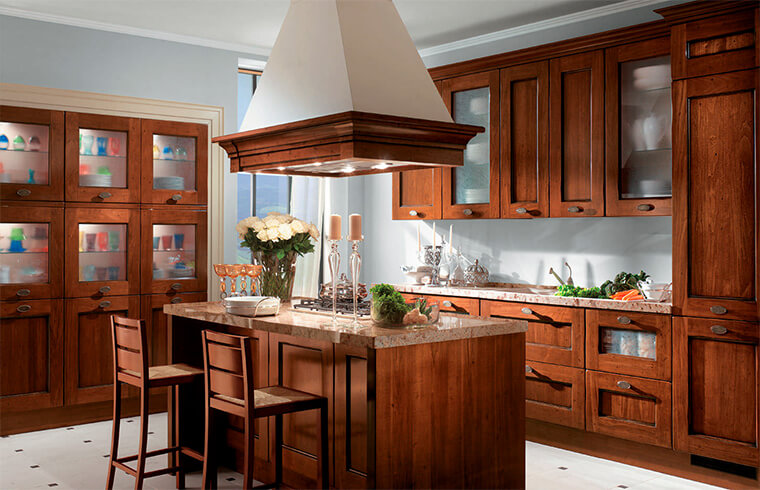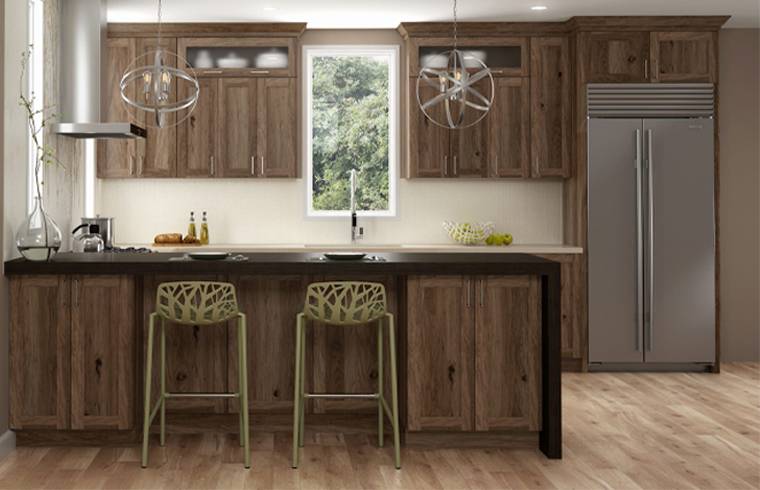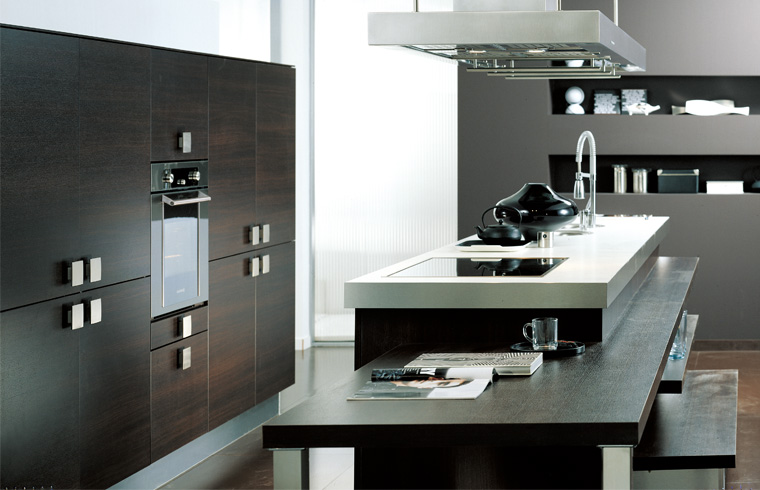When it comes to designing a dream kitchen, cabinets are more than just storage. They set the tone for your space, impact functionality, and even affect your home’s resale value. Among the many choices available, walnut kitchen cabinets and cherry kitchen cabinets stand out as two of the most sought-after options. Both are known for their natural beauty and long-lasting quality, but they offer very different styles, finishes, and price points.
If you’re unsure which one is right for your kitchen, this guide will walk you through their appearance, durability, finishes, cost, and design applications—so you can make an informed choice with confidence.
The look and feel of your cabinets will influence the overall mood of your kitchen. While both walnut and cherry are elegant hardwoods, their colors and grain textures tell different stories.
Walnut is known for its striking, naturally dark tones — ranging from warm light brown to deep, almost black chocolate. It has a strong, mostly straight grain with a slightly coarse texture, giving it a bold, artistic appearance. The grain is open and expressive, often featuring waves or curls that catch the light beautifully. This makes walnut a favorite for modern, minimalist, and luxury kitchens where drama and contrast are desired.
Cherry, by contrast, starts with a much lighter, golden-pink or honey tone and gradually develops into a rich, warm reddish-brown. It has a fine, smooth, and closed grain, which gives it a soft, elegant, and consistent surface. The wood often includes small natural knots and subtle variations that add character without overwhelming the design.
In terms of style, cherry leans traditional, fitting perfectly in classic American, farmhouse, or transitional kitchens. It brings a sense of comfort and timelessness. Walnut leans modern, often used in contemporary or high-end designs where a sleek, refined look is key.
Lighting plays a big role in how each wood appears. In bright, natural light, cherry looks warm and inviting, while walnut can appear deeper and more luxurious. In lower light, walnut may feel cozier, while cherry maintains its soft glow.
Ultimately, your choice depends on the mood you want to create: cherry for warmth and tradition, walnut for depth and modern elegance.

One of the most fascinating aspects of natural wood kitchen cabinets is how they change over time — and cherry and walnut age in nearly opposite ways.
Cherry wood darkens significantly as it’s exposed to oxygen and sunlight. This process, called oxidation, enhances its natural beauty. A newly installed cherry cabinet may look light and golden, but within a few months to a year, it will begin to develop deeper, richer red-brown tones. This transformation continues slowly over many years, giving the kitchen a more mature, luxurious feel.
A real-world example? Cherry hardwood floors in a sunlit room often show noticeable color variation — areas under rugs stay lighter, while exposed areas turn darker. The same will happen with your cabinets. That’s why it’s important to ensure even light exposure across all cabinet surfaces to avoid patchy color differences.
On the flip side, walnut tends to lighten slightly over time. Its deep chocolate color may fade into a warmer, amber-brown, especially in areas with strong sunlight. While this softens its initial drama, it doesn’t diminish its elegance — instead, it adds a lived-in, organic charm.
Importantly, sunlight doesn’t damage the wood — it simply speeds up the natural aging process. Even in low-light kitchens, both woods will change color slowly due to oxidation.
These aging behaviors are not flaws — they’re part of the unique character of solid wood. If you appreciate a kitchen that evolves and gains personality over time, both cherry and walnut deliver — just in different directions.
Beyond looks, kitchen cabinets need to withstand daily use. Both walnut and cherry are durable hardwoods, but there are slight differences in their strength.
Measured on the Janka hardness scale, walnut scores around 1,010 and cherry about 950. This means walnut is slightly harder and more resistant to dents and scratches. However, the difference is small enough that both perform well in everyday kitchen environments.
If your kitchen is a high-traffic space with children or frequent cooking, walnut may have a slight edge in resilience. Still, cherry’s strength is more than sufficient for most homes, especially with proper care.
Choosing the right finish can enhance the beauty of your cabinets and protect them from wear. With walnut and cherry, the natural wood grain is the star, so many homeowners prefer finishes that highlight rather than cover it.
A clear coat is the most popular option for both walnut and cherry kitchen cabinets. It protects the wood while allowing its natural color and texture to shine through. For cherry, a clear finish works especially well because the wood naturally darkens over time, eliminating the need for heavy staining.
Walnut’s velvety grain also responds beautifully to a clear finish, creating a smooth, elegant surface. While light staining can adjust the tone slightly, heavy stains or opaque paints are rarely recommended—painting over walnut or cherry hides their distinctive patterns, which are often the main reason people choose these woods in the first place.

Cost is a deciding factor for many homeowners, and both walnut and cherry sit at the higher end of the kitchen cabinet price range. They are generally more expensive than maple, oak, or birch, and price can vary based on wood grade, supplier, and market demand.
On average, walnut kitchen cabinets are about 5–15% more expensive than cherry kitchen cabinets. Walnut’s higher price is due to its relative scarcity and the demand for its rich, dark tones in modern design.
If you love the look of walnut or cherry but have a limited budget, consider using them selectively—such as for a kitchen island or accent cabinets—while using a more affordable wood for the rest of your kitchen. You can also explore wood veneers or high-quality laminates that mimic the look of natural walnut or cherry at a fraction of the cost.
For homeowners who care about sustainability, both walnut and cherry can be eco-friendly choices if sourced responsibly. Look for suppliers that offer FSC-certified wood, which ensures the material comes from responsibly managed forests.
Because walnut trees grow more slowly, they can be less sustainable if harvested irresponsibly. Cherry, on the other hand, is more common in certain regions, which can make it a slightly greener option depending on the source.
Choosing a finish with low-VOC (volatile organic compound) content is another way to make your kitchen healthier and more environmentally friendly.

Your choice between walnut and cherry should align with your design vision.
Walnut kitchen cabinets excel in modern, contemporary, and transitional spaces. They pair well with lighter countertops, stainless steel appliances, and open floor plans. The contrast between dark walnut and white walls or marble surfaces creates a striking, high-end look.
Cherry kitchen cabinets shine in traditional, farmhouse, or rustic kitchens. They complement warm color palettes, natural stone, and classic design details like crown molding. The deepening color over time enhances the cozy, timeless feel.
Some homeowners even combine the two—using walnut for a statement island cabinet and cherry for perimeter cabinets—to create visual interest and a layered design.
Here’s a quick reference to help you compare:
Feature | Walnut Cabinets | Cherry Cabinets |
Color | Dark brown to chocolate, lightens over time | Reddish-brown, darkens over time |
Grain | Straight, bold, occasional waves | Fine, smooth, uniform |
Hardness | ~1010 (slightly harder) | ~950 |
Style Fit | Modern, transitional, industrial | Traditional, warm, classic |
Price | High, usually 5–15% more than cherry | High, but slightly less than walnut |
Maintenance | Moderate, occasional polishing | Moderate, occasional polishing |
Deciding between walnut and cherry kitchen cabinets comes down to your personal taste, lifestyle, and budget. If you’re drawn to sleek, modern designs and prefer a darker, more dramatic tone, walnut may be your best fit. If you love warmth, tradition, and a wood that gains depth with age, cherry could be the perfect choice.
Both are durable, beautiful, and timeless investments that can elevate your kitchen for decades. By understanding their unique qualities and considering how they fit with your home’s style, you can choose confidently—and enjoy a kitchen that’s as functional as it is stunning.
Ready to bring your dream kitchen to life? Whether you choose walnut kitchen cabinets, cherry kitchen cabinets, or a combination of both, working with a trusted cabinet maker will ensure you get the quality, finish, and design that suits your space perfectly.
We employ cookies to analyze website traffic and enhance your browsing experience. Data securely aggregated, privacy protected. See Privacy Policy for details.